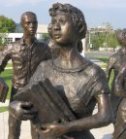
Joe's Stories from the Road
for the month of October 05
Oct 10
New Baby, Helpers, Atomic Bomb, Boll Weevils
While on a 14,000-mile bicycle trip wonderful things
about life happen. Last
week, a new baby came into my life.
I am Papa Joe again and this time it is because of a beautiful
little girl named Marlena Iris.
My daughter, Natalie, and her husband, David, and had a new
little baby. They sent me
photographs and she is beautiful.
Barbara said she was beautiful, too, and she is an expert so I
take her word for it.
Congratulations, David and Natalie.
I love all three of you.
Sometimes I forget to mention people who have greatly
helped me make this bicycle trip happen.
Many I have already mentioned but two who I think of tonight I
haven't mentioned. One is
Richard White who is in the logging business in Morehead, Kentucky.
Richard, your contributions have helped me to stay in motels more
than on the ground in a sleeping bag.
Thanks for believing in me.
The other is Mark and Cindy who own Pedal The Planet Bicycle
Store on Richmond Road in Lexington, Kentucky.
They keep my bicycle running.
Recently I had a broken wheel in a town that had nothing but
Mountain Bike shops. I
called Pedal The Planet and they built me a new wheel with cluster and
sent that along with two new chain rings for the front and I had them,
at no charge, the next morning.
Thank you folks for believing in our project and helping us.
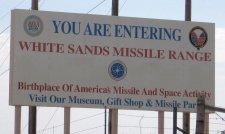
After I left San Carlos Reservation I was soon across
Arizona. Then New Mexico.
I stopped on top of the mountain where officials watched the
first explosion of the Atomic Bomb on July 16, 1945.
After that explosion the world changed forever.
I stood there and tried to imagine a world without this awesome
power. What would one think
as it exploded and the dark night turned white with light as far away as
Texas and Arizona. The man
in charge of the Manhattan Project wanted to stop the process after
witnessing the experimental explosion because he knew the awful
consequences ahead.
I
pedaled on across the White Sands Missile Test Range and climbed into
the Sacramento Mountains.
It was the third most feet gained in elevation in one day on the trip.
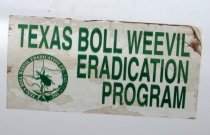
Soon I was across New Mexico and into the peanut, cotton and oil country of West Texas. I visited with the ranchers and the boll weevil exterminators and pedaled on across Texas. They are a good hard working people. I crossed the Red River between Texas and Oklahoma yesterday. And here their Red River is actually red. I took some photos that David will share with you later. And then I hit the Chisholm Cattle Trail. I rode almost 100 miles of it while visiting its people and the museums along the way. This was the trail where the cattle of Texas and Oklahoma were driven to the Railroad Head at Abilene, Kansas, so they could be shipped back east for human use. Now I am continuing across Oklahoma.
Oct 16
Oklahoma City Memorial, Pat and Jan, Ken, Will Rogers, The Dalton Gangp
It seems like I have been traveling fast and I guess
you might say I have. But I
just checked and in the last thirty days I have covered 1,500 miles and
that is exactly the mileage that Cliff and I covered the first thirty
days of this bicycle trip.
If I can keep up the pace I will be very near 10,000 miles when I
go home for Thanksgiving.
This is incredible that I get to do this for a second
time in my life. I can
write all the words that come into my head but I tell you there is no
way that I am able to share totally with you the awesomeness of doing
this. I have watched the
great Pacific from atop the mountains of Big Sur.
I have ridden through hundreds of valleys and crossed all the
major mountains of the west.
I have ridden up and down our mighty rivers.
I have crossed the Continental Divide eleven times this summer.
I have watched in awe some of America’s largest wild animals- and
the smallest, too. I have
listened to winds and the birds and the stress-cracking of trees in the
northwest.
Believe it or
not, even the guard rails along our highways play a symphony in the
early hours of morn when the sun begins to rise and heat the metal.
I have felt the cold and the heat.
Man, what heat I have endured.
But it was good, too.
If it aggravates you then you know you are very much alive.
I have dipped my worn out feet in cool streams this summer.
And that feels so good.
I have eaten my lunch across the highway from a bear who was also
eating his or her lunch. Of
course I didn’t know it at the time.
A truck driver had to stop and let me know.
I have crossed a lot of deserts and met many of our Native
Americans- who are fantastic Americans.
And I have met all kinds of folks along the highways.
Many of them from other countries visiting our great country.
Just wanted to think about this for a moment.
And I thank my God that I am able to do it again and thank all
the people who have made it so wonderful.
I am having a VISIT with AMERICA and I have got to tell you that
doing it on a bicycle is the best way.
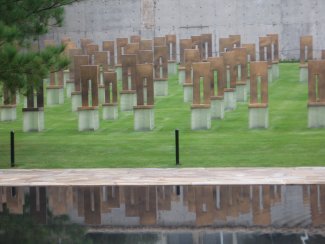
Oklahoma City Memorial
In the last four days I have visited four states;
Oklahoma, Kansas, Missouri and Arkansas.
Just a few days ago I was in Oklahoma City and visited the
memorial built to honor the people who lost their lives in the bombing
of the Federal Building in that great town.
It was haunting to step inside the walls that protect the
city-block-long memorial. I’ll send photos. The chairs we see in the
photos are lined up along the walls and partitions of the building.
You will notice small chairs and large chairs.
The small chairs represent the little children who lost their
lives. You will note a
reflection pool. The pool
is where the asphalt street was located in front of the building.
The trees planted along the outside walls of the building will
grow to be 70 feet tall, which is the height of the building.
There is one large tree in the corner.
It is the surviving tree and a wall is built around it.
On each end of the reflection street is a wall.
One reads 9:01 and the other reads 9:03.
9:02 was when the bomb destroyed the building.
I was there for about two hours and hundreds of people quietly
walked around the grounds in a meditative state.
Near Edmond, Oklahoma, I examined my bicycle.
It had been skipping gears.
A man got out of his truck and introduced himself. Pat Dukes.
Seeing that I was having problems, he said he knew of a nearby
bicycle shop and that he would be happy to take Rocinante and me to it.
At the bicycle shop, after a considerable amount of work was done
on the gearing, Pat wouldn’t let me pay the bill.
He picked up the tab and as we were going back he invited me to
stay all night with him and his wife, Jan.
I gladly agreed. That night
they took me to Edmond for a delicious dinner.
Before going in the restaurant we walked up and down the
sidewalks taking photos of their many bronze statues.;
I found one that I wanted to take home with me.
It was life-sized and portrayed a young boy struggling to walk on
a pair of home-made stilts.
I stood there and told Pat and Jan the story about the 3,008-mile
stiltwalk across America.
Thanks for a great evening, Pat and Jan.
Keep up your good work.
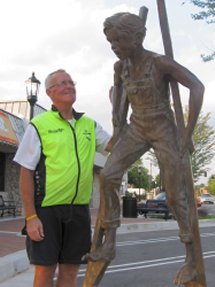
The bronze kid on the right is getting advice from the man who holds the World Record for Longest Stiltwalk- Joe Bowen.
Ken Harwood was the man who ran the publicity for the
stiltwalk in 1980. He has a
great personality and I enjoyed working with him.
His work made the walk a huge success.
He even got me written up in Time Magazine.
I still have a copy of that one, Ken. Anyway, while pedaling through Tulsa I called information and
they gave me his phone number.
Had no idea that he still lived in the area.
I called him and we had dinner together and did a lot of talking
about old times. Ken pulled
off one of the coolest things I have heard about.
Several years ago there was a man who was going to write a coffee
table book about the United States Jaycees.
It was going to celebrate 75 years of their history.
Well, the man that was going to write it ran out of time and
really couldn’t finish the book.
Ken had left the Jaycees office and was working for himself.
The Jaycees approached him and told him that the other man could
not complete the project.
They asked Ken to do it for a fee.
There was one stipulation.
He could not take any credit anywhere in the book for writing the
book. The Era of the 1980s
honors me with a story of the stiltwalk and three photographs.
One is when I actually broke the Guinness Book of World Records
with the Muscular Dystrophy children holding the ribbon.
It occurred at halftime of a Rough Neck Soccer game with 25,000
fans. Back to the story.
Ken agreed to write the book and that his name would not be in
the title page. But
coincidentally each chapter started with a large Old English letter.
And when you look at the beginning of all the chapters, the Old
English letters spell KEN HARWOOD.
How cool is that? He
didn’t break any rules but his name is on this beautiful coffee table
book.
I rode into Claremore, Oklahoma.
This was a memorable place on the 67 trip.
Back then, I was given a tour of the Will Rogers Memorial by
Rogers’ niece, Paula McSpaden Love.
And earlier in the day I had the honor of meeting JM Davis who at
the time had the largest privately owned gun collection in the country.
He personally showed me his collection.
Hundreds of pieces, maybe thousands, were hanging in every bit of
space in his old three story hotel in downtown Claremore.
Now the collection is housed downtown in a fireproof museum.
Mr. Davis passed away in 1973.
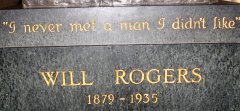
This time I stopped in at the local newspaper office
to tell the editor my story.
If they were interested.
I haven’t done this much on this trip because others are taking
care of this. But I had
wonderful feelings about being in the their town again on a bicycle and
I wanted to stop. The
editor, Clarice Doyle, made me very feel welcomed and we talked a long
time. She made arrangements
for me to be treated royally again at the Will Rogers Memorial.
The curator, Michelle LeFebre Carter, took Clarice and me on a
tour. Michelle asked if I
would like to visit Will Rogers’ tomb.
Absolutely. It is
not open to the general public.
But I got to go below ground and see where Will Rogers and his
family lay in state behind marble stones.
It was a very special treat.
Jack London, Mark Twain, Will Rogers and John Steinbeck were my
favorite writers when I was growing up.
I even dreamed about being able to tell a story on paper like
these men could. But
somehow I never got around to doing that.
All four are still important on my reading list.
When I got to Ollogah, Oklahoma, I looked for the
statue of Will Rogers watering his horse in the town’s watering tank.
Two blocks before I got there I noticed an older lady standing
beside her car. She had
driven up on a curb and was hung up.
Several high school boys came by and we lifted the car back into
the street. I asked them
where the Will Rogers statue was located.
And one young chap asked, “The one where Will is talking on a
cell phone?” I didn’t know
about the cell phone but I guessed that was the one I wanted to see.
I found it and Will is scratching his head and it does look like
he is talking on a cell phone.
The next stop was Coffeyville, Kansas.
That was the town where the Dalton Gang tried to rob both banks
in town at the same time.
It didn’t work out too well.
Three of them were killed by local folks who had had enough of
them robbing banks. Brother
Emment lived and spent the next fifteen years in prison.
The Gang had tied their horses to an iron pipe in the alley that
is now called Dead Man’s Alley.
The pipe, for fifteen years, was the only grave marker that the
Dalton boys had. Emment put
up a stone after he got out of prison.
While I was visiting the cemetery a local man about my age showed
me where they were all buried. Way
in the back. By themselves. He shared a story with me about the
pipe. He said that when he
was a little boy his dad told him to go over to the pipe and holler into
it, “What are you all doing down there?”
He said his dad told him that, “They would say NOTHING.”
The man told me he did what his dad said and then knew that he
had been had. David Mink, a
journalist for the local newspaper, took me to both of the banks the
Dalton Gang robbed and told me the story of how it all happened.
Oct 5, 1892. Four of
the local folks were killed, also.
I did some banking at one of the banks that was robbed of $20,000
that day.
Approaching Baxter Springs, Kansas, Joplin, Missouri
and today in Northwestern Arkansas I am reminded of sweet home Kentucky.
The maples are red, the walnuts are bright yellow and the sumac
is crimson. The blue skies,
green pastures, and fall colors remind me that I am close to home.
I will see you Kentucky folks soon.
Oct 23
Little Rock, Arkansas Nine, Clinton Center, Peabody Ducks, Mr. and Mrs. Beauford Gray
The second time through Little Rock on a bicycle was much different than in 68. This time, I pedaled down the river road. A fellow bicyclist told me how to get on the new Little Rock bikeway. I found it easily and pedaled down the north side of the Arkansas River into downtown Little Rock. Most of the city is on the south side so I was privileged to a great view of the beautiful downtown skyline with the clear waters of the River in the foreground. The temperature had cooled down and the ride was spectacular. I wanted to see three things in particular before going on down to where I stayed with Mr. Gray. First was the Peabody Hotel, one of the finest in the United States. I knew I had to stay there my only night in Little Rock. Also, I wanted to visit the Clinton Center and the Capitol Building again. I could see all three on my bikeway ride into downtown.
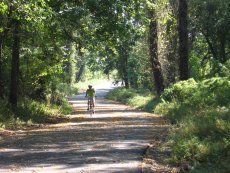
Bikeway.
For several days, people up and down the river told me
that the Clinton Center looked like a mobile home.
Well, maybe a little from a distance.
But up close it is an awesome building and a very interesting
stop. I couldn't stay as
long as I would have liked.
I still had to see the Capitol Building before darkness fell.
The Capitol Building and grounds were immaculately groomed and
cared for. But there was
one very special group of statues that I had to see and photograph for
the school children back home.
It was the Arkansas Nine.
The nine children who were escorted into Central High school by
the National Guard to end segregation in the South.
Very moving.
Especially to me. Standing
there and then walking around the life-sized statues of the young
children, I thought about the first time I visited Little Rock and the
Capitol Building. Things
have changed. The city is
now beautiful. The Arkansas
Nine statue is the first, and for now the only, memorial to
desegregation on the grounds of a southern capitol.
I met one of the grounds keepers and he told me that the Arkansas
Nine had only been up since August of this year.
He said that it is interesting to watch people walk up to the
statue of the school children.
He said some people actually set down on the grass and begin to
cry.
And then to the Peabody Hotel.
As I pedaled under the great canopy I noticed that they offered
Valet parking. I didn't
offer and no one asked. I
rode up to the huge sliding glass doors.
Slowly they opened.
I rode through the first set and then the inner doors spread open.
I continued riding into the huge lobby with the marble floors and
the grand fountain. I
dismounted at the check-in counter and asked for a room.
"All of our regular rooms have been taken, Mr. Bowen."
I looked around to see how she knew me.
She smiled as I realized that my jacket has JOE BOWEN sewn into
the front breast."Then
what do you have?" I asked.
I had decided a long time ago that I was staying at the Peabody in honor
of my friends, Mr. Beauford and Mrs. Effie Gray.
"All we have available is the Club on the eighteenth floor,” she
answered. "Then I
will take that," I explained.
She took my debit card and drivers license.
After the information was printed out she asked, "Would you
please sign here, Mr. Bowen."
As I began to sign I noticed that I had just rented a room in the
Peabody Club for $277.00 for one night.
The lady behind the desk must have noticed something and stated,
"You will never regret staying with us, Mr. Bowen.
That is somewhat different than the two dollars that Mr. Gray
charged me in 1968.
And by the way, no one said anything to me about
riding in. When I left, I
saddled Rocinante in the Grand Lobby of the Peabody and rode out.
The Duck Master noticed me when I rode in on the bicycle.
What’s a Duck Master?
He’s the guy in charge of the ducks. Let me tell you about the
ducks. Every morning at 10:00 the magnificent elevator stops at the
Grand Lobby. A red carpet
is spread across the polished marble floor leading to the fountain. The
elevator door opens- and out waddles a flock of ducks. They go straight
to the fountain and enjoy their day. At 5:00 PM, they get out of the
fountain, waddle back across the red carpet and get on the elevator.
People always gather to watch.
The Duck Parade started in the Peabody Hotel in Memphis, TN, in
1940 and people have been enjoying it ever since. Back to the Duck
Master. He asked me what I
was doing and then asked if I could stay around a few minutes and tell
the guests what I was doing before the ducks came out of the fountain.
I did stay and enjoyed telling about the bicycle trip and about
the children back in eastern Kentucky. I then stepped aside and the Duck
Master explained all about the Kentucky Unbridled Spirit.
Then I watched the ducks walk down the Red Carpet. The Duck
Master arranged it so the ducks would walk right past Rocinante so I
could take a photograph of them together.
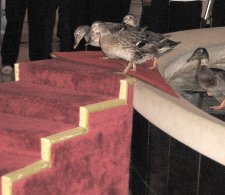
Peabody Hotel ducks.
I understand we have a contest going on with the
students for the best creative answer to the question. “Where do the
Peabody Ducks go when they get off the elevator?”
I’m looking forward to reading the answers.
The next morning I rode out of town.
I was looking for Mr. Gray’s place.
The street that I had gone down in ‘68 where all of the windows
were broken out is gone now.
In their place is an Interstate Highway.
Soon, I was leaving Little Rock.
I stopped several places and asked about Mr. Gray.
At a post office I found a gentleman who knew Mr. and Mrs. Gray.
He told me where their place was.
I rode a short distance and there it was.
The store, the four or five room motel, and across the street,
their home. Their place was
abandoned and everything was grown up in weeds.
The street between the store and their home had been named Gray
Street. I was saddened as I
photographed Rocinante leaned up near the store.
But I also had warm, good feelings rushing through my veins. Mrs.
Effie Gray had fixed me a home-made breakfast of hot eggs, sausage, big
hot biscuits with gravy and hot coffee back in 1968.
And all had turned out well. Mr. Gray had perhaps saved my life
and I was glad visit him and Mrs. Gray again and honor their memory.
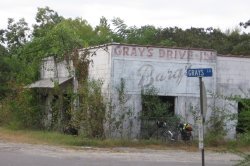
Now in disrepair, but in 1967, Mr. Grays Hotel was a beautiful shelter from the storm. It was owned and operated by two of the finest people Joe met on his trip.
(Editors Note: Teachers, the following narrative concerns the racial tension of 1968. Although the language of the narrative has been cleaned up, it is about a disturbing part of our nation's history. It is probably not appropriate for young students.)
***Following is Joe's current Preface to the 1968 manuscript describing the Little Rock experience***
During the first bicycle trip I was in Claremore,
Oklahoma, in the spring of 68 when I learned that Martin Luther King had
died from an assassin’s bullet.
During the entire bicycle trip the country was in a state of
unease. In the Tulsa
Tribune the morning that I learned of King’s death, it was obvious that
the country was in a major panic.
We were coming apart at the seams because of the race riots and
the riots and demonstrations against the Vietnam War. And in a few days
I would pedal into Little Rock.
Little Rock and Pine Bluff, Arkansas, and Memphis,
Tennessee were in a mode of total self-destruction.
I couldn't turn around and I couldn't stop and go home.
I had committed to myself that I would see this bicycle ride
through to the end. So,
scared to death, I pedaled on toward Little Rock.
It was on my schedule because I had been visiting as many state
Capitols as possible. During the bicycle trip several governors had met
with me when I was in their Capitol.
I rode into Little Rock from Hot Springs.
I walked up the steps of the Capitol building but did not go in.
A reporter from the newspaper stopped me and we talked.
I was back on the bicycle and going south on the city streets
looking for Highway 365 that would take me to Pine Bluff.
As I rode down the streets, African-Americans were knocking out
plate glass storefronts with bricks and stones.
***FROM JOE’S 1968 MANUSCRIPT***
When I got into Little Rock, Arkansas, I
experienced a little of the pain that was caused by the racial strife
that was crippling our great country.
After the assassination of Doctor King, I had considered not even
riding into the South. But,
after a couple of days, I reconsidered and decided that the cities of
the South were America, too, so I was compelled to go.
I was obligated to myself to see all of America.
And besides, I was a Southerner by birth.
I rode into Little Rock three days after Doctor King’s
assassination. The first
part of town I saw was quiet and peaceful.
“Well, “I thought, “Maybe I won’t have too much trouble after
all.” I stopped at a small
restaurant and ate a sandwich. The day was coming to an end, so I pedaled south, hoping to be
out of town by dark.
Unfortunately, the town was spread out more than I had expected and took
more time to cross.
As it began to get darker, the streetlights along the
asphalt boulevards came on.
Soon after, I rode through the central part of town and began getting
into what is known as South Little Rock.
It’s where most of the Negroes lived and seemed to be the older
and more dilapidated part of the city.
The street was cluttered with bricks and cans and bits
of paper. Some of the plate
glass windows in the storefronts stood in splinters.
Others had been knocked completely out.
I passed young black men who stared at me with hatred as I
continued pedaling and I tried not to look at them.
I kept my head straight ahead.
I didn’t want to provoke anyone into bashing my head in.
I heard someone yell!“Hey, you ____ ____,
stop that bicycle!” “Come
back here, you ____ ____ _____ ______!” another one yelled.
My mind became foggy with a sudden hatred for people I
didn’t want to hate. I was
scared that one of them would get in a car and come after me.
But, I also wanted to stop and smack hell out of just one of
them. But I knew that would
be suicide. My tolerance
level had been reached and only through sound judgment did I pedal
harder and harder to avoid a confrontation.
Darkness came, leaving round shadows on the pavement
between the purple-white streetlights.
I knew it was hopeless to look for a place to camp.
Even if I found one there was a big chance that someone would
find me and kill me in my sleep.
I saw a neon sign three or four blocks in front of me.
I could make out the letters “TEL” through some overhanging tree
limbs. I pulled up in front
and parked the bicycle in a well-lighted place to discourage anyone from
stealing it while I was inside.
It was a small restaurant/motel combination.
Cobwebs hung from corners.
Two or three small lamps hung on the wall, putting out very
little light. There were no
customers, just a short white lady in her mid-fifties standing behind
the counter. I sat down on
one of the stools in front of her.
“It’s sure getting rough out there, isn’t it?”
I said.
“Yes it is.
It stays that way.”
She began wiping the table in front of me nervously with a wet rag.
“Could I help you?”
“I’d like to know how much one of your rooms is.”
“By yourself?” she asked.
“Yes. I’m traveling by bicycle.”
She seemed surprised.
“You’re traveling by bicycle? One that you pedal?” I grinned and
nodded.
She got a napkin and a fork out of a tray and lay them
in front of me. “The best I
can do is fourteen dollars.”
“Fourteen dollars?
For a room in this place?
I didn’t expect to pay fourteen dollars for a room in a place
like this. I had planned on
paying not more than five.”
I had already gotten on the defense.
She stopped working and looked at me for the first
time, eye to eye. “Mister,
do you sleep in motels much?”
“No, I camp out most of the time.”
“Well, you won’t camp out there, not tonight.
In fact, if I was you I wouldn’t even ride down that road, not
even in the daytime. Them
____ will kill you before you get ten blocks out there tonight.”
In a flash, I was mad again.
“That’s where you’re crazier than ___.
Are there any more motels down the road?”
It was not only an economical decision, I was upset because she
had doubled her prices because of the racial problem and maybe because I
was traveling by bicycle.
“Not until you get to Pine Bluff.
Forty or fifty miles down the road.”
I pushed back the cup of coffee she had served me.
“Well, I’m going to Pine Bluff.”
“I tell you, them ____ will kill you before you get
ten blocks.”
I pulled the door open and turned so that I could look
her in the face. “Lady, I’d
let them “___” cut me into pieces and strew me along the street before
I’d pay you fourteen dollars to stay in this hole.”
I slammed the door and left.
I had not pedaled more than seven blocks when I came
upon another motel. It was
built of concrete blocks, and, the way the streetlight shined on it, it
looked as if it needed a new paint job.
The office was closed.
There was a house next door with its lights on, so I went over to
see if the people knew who ran the motel.
A black woman dressed in a long nightgown, with her
hair messed up with sleep in her eyes, came to the door.
“Could you tell me who runs the motel here?” I asked.
“Yes. We
own the motel.”
Thoughts flashed through my mind.
Should I stay in a black man’s motel on a night like this?
I guessed it couldn’t be any worse than staying with that lady up
the road.“I’d like to have
a room.”
“Let me get my husband,” she said, then closed the
door.
Surely she wasn’t going to call for help.
I hadn’t done anything to her.
I would look stupid if I ran, and besides, if she were calling
for help, there was no place for me to run.
I waited. A tall,
broad-shouldered black man came to the door, fully dressed.
I felt my hands trembling, so I grasped the handrail leading up
to the door to steady them.
It eased my mind when he spoke.
“Could I help you, son?”
“Yes, sir,” I said.
“I need a room and want to know how much you charge.”
I can let you have one for two dollars,” he answered.
I told him I would take it, and he pulled a string of
keys off the inside door-facing.
“Where’s your car?” he asked.
I told him I did not have one and that I was traveling
by bicycle. I told him what
I was doing and about the lady up the street.
As we walked down the sidewalk in the dim light, the sky was
glowing red beyond the trees on the other side of the road. I saw sparks fly high into the air.
“I don’t know why they burn their own homes down,” the
proprietor remarked.“If I
was going to burn one, it wouldn’t belong to a black man.”
I asked him what he meant.
“See that?” he said, and he pointed toward the glowing
sky. “Those are black men’s
homes and they’re burning them down themselves.”
He shook his head and, talking half to himself, muttered: “I
don’t understand why they do it.
I just don’t understand.”
He unlocked one of the motel doors, pushed it open,
and turned the light on as I wheeled the bicycle inside.
“It ain’t much, but you’ll be safe here.”
The room was lit by a hundred-watt bulb hanging from
the ceiling, and the floors were tiled.
No fancy carpet or fancy bathroom, but it would keep me from
paying $14 and keep me from losing my head.
I trusted the big man.
Morning came and I was awakened by a rapping at the
door. I opened it and there
stood the motel owner. He
smiled.“The wife wants to
know if you’d come over and have breakfast with us before you leave.”
The man’s friendliness amazed me.
“Yes,” I told him.
“I would enjoy eating with you.”
I was a little lost for words as we walked toward the
house. “I’ve never eaten at
a Negro’s table before,” I said, half embarrassed.
This seemed to strike him as funny.
“Oh, that’s okay,” he grinned.
“We’re not much different than any other human family.”
I caught a great deal of understanding in his
statement. To many black
people, my comment would have offended, but to him it was funny.
On the table sat a heaping plate of scrambled eggs,
fried potatoes, biscuits and gravy, sausage, and a cup of coffee.
Steam rose from the hot coffee.
I took a second helping of eggs and plenty of coffee.
It wasn’t often that I could eat all I wanted.
After we had eaten, the motel owner, whose name was
Beuford Gray, his wife Emmuelle, and I sat and talked for two hours and
drank nearly a pot of coffee.
Most of our conversation was about the race problem and the
rioting that was breaking out all over the country in the wake of Doctor
King’s murder.
“Joe,” Beuford said, “a lot of our people don’t want
to do any better, but there are many that do.
And, those that don’t, make it hard for the others.”
He paused, and then continued, “It’s the same way with the white
people, too.”
“How do you mean that?” I asked.
“Well, last night, after you had gone to your room, we
got a call saying the home of some of our friends had been burned down.
Black men burned it down.
These friends have been struggling to get on top.
They had bought their home.
It wasn’t a fancy home, but it was a start – and now some of
their black neighbors have burned them out.”
“Why did they burn their friends out?”
Beuford had mentioned the burnings the night before, so I figured
it was a sore point with him.
“Well, let me say this,” he said.
“If I was going to burn someone out, you can bet it wouldn’t be a
black man. There’s plenty
of whites in this town.”
“You mean you think they should burn the white
people’s homes?”I knew
that was not what he meant, but I wanted to keep him talking.
He became impatient with me.
“No, I don’t mean that at all.
I mean it just isn’t logical to burn yourself out when you are
mad at someone else.”
We talked.
My ideas about our racial problems and the black people became
more clear. I was raised in
the eastern hills of Kentucky and there I had learned that black people
were ‘niggers’. There are
still some ignorant, backward people there now who think they are
‘niggers’. But, my mother
had also taught me that there never was and never would be a beneficial
purpose for the use of the word ‘nigger’.
And during the bicycle trip her teachings took on a much greater
meaning.
After breakfast Beauford and I took our coffee out on
his patio. While sitting there I noticed a Television News van go down
the highway and slow down.
In a few minutes the Van drove back, slowing down again as it passed.
Then it came back down the highway and this time it turned in Mr.
Gray's driveway. Mr. Gray,
sitting in a reclining lawn chair, looked over at me and said, "I didn't
think you would care. I
called them. Thought it
would be good for them to see a black man and a white man drinking
coffee together and enjoying each other’s company."
The three newsmen were smiling when they got out.
"Is this Mr. Gray’s home?"
We did an interview for the TV station and another for the radio
station rep that was with them.
Before I left to go south, Mr. Gray told me I had to do something
with him. Together, we
wrote an article for the Southern Journal, which was an all black
newspaper at the time. He
told me that a photo of us together would be good for them, too.
Time had come for me to be on my way.
After thanking my new friends for my enlightenment, I pedaled
southward. The old lady at
the first motel had been right about one thing.
It was forty or fifty miles to Pine Bluff.
On the outskirts of Pine Bluff, I heard a car horn
blow behind me two or three times.
I looked back and saw a blue automobile with a black man and
woman in it. They were
smiling.“I wonder if
they know me.” I said to myself.
The car passed and pulled over to the side of the road
and stopped. It’s occupants
got out, and I recognized Beuford and Emmuelle.
Beauford got out and walked up to me.
"Joe, we were on the noon news in Little Rock.
Effie (Beauford's wife’s nickname) was worried and said we needed
to drive you through Pine Bluff.
“Yes, Joe, honey, we got worried about you,” Mrs. Gray
said.
Mr. Gray added,
“Pine Bluff is having some race problems downtown and we figured
we’d come down and drive you through town.
We were afraid maybe you’d get hurt.”
That pleased me.
“White people don’t treat me any nicer than this,” I grinned,
half-kidding.
He winked at his wife.
“Why should they?
I’m just as much human as they are.”
He was wrong about that, of course.
He and his wife were showing what humanity really meant.
We put the bicycle in the trunk and drove into town.
Beuford turned right off of the main road.
“Oh,” I said, “I’m going to Tallulah, and it’s south
of Pine Bluff.”
“I know where Tallulah is.
I’m going to take side streets to get us through town.
If we went through together, they’d drag us both out.
The whites would call you a ‘nigger’ lover and the blacks would
call me a ‘honky’ lover.”
I had only been with this man a short while, but
somehow I felt he had been around and probably had been quite a rebel in
his youth. As we drove down
the side streets of Pine Bluff, he confirmed this idea.
“Joe,” he said, “I don’t know if these people will
ever learn what I learned a long time ago.
They’re going to have to sit down and talk and compromise with
each other. If they don’t,
every town in this country is going to be burned down.
I used to be out there where they are, but not no more.”
South of Pine Bluff, with the Ozark Mountains visible
far to the north, I was in the Mississippi Valley.
My black friends stopped the car and let me out.
As we departed, I could not think of anything to say, except,
“Thanks a lot for everything.
I really appreciate you-all.”
Beuford had given me so much to think about, I could not talk.
I stood and watched his car make a U-turn in the highway and head
back toward Little Rock.
Later they sent my mother a letter telling about me
staying with them and in the letter was several photos that Mrs. Gray
had taken while I was there and the article that appeared in the
Southern Journal. In the magazine was a picture of a Black man and a
White man, drinking coffee and enjoying each other’s company.